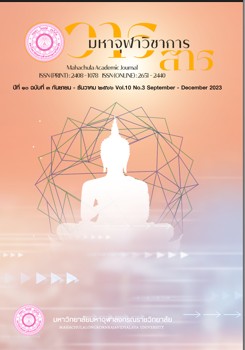The Interaction of Mind and Matter in Theravāda Buddhist Philosophy
Main Article Content
Abstract
This research paper aims to provide a thorough examination of the intricate relationship between the mind and matter within the domain of Theravāda Buddhist Philosophy. The study encompasses an extensive analysis of numerous canonical texts such as the Tripitaka, Commentaries, as well as relevant Thai and English sources. The findings of this study reveal that the mind possesses a multitude of distinct characteristics, serving as the fundamental essence from which all matter - be it in the form of objects or non-material entities - derives its existence. In the context of Theravāda Buddhist Philosophy, matter refers to concrete objects and elements, namely the four elements, which represent the origin of identity, vital force, and the world. This research focuses on elucidating the dynamics of the interaction between the abstract nature of the mind and material forms. Mind and matter are identified as two distinct yet interconnected entities that mutually interact and support one another. They jointly contribute to the causal processes underlying human existence. Consequently, a holistic understanding emerges, encompassing both the mind and matter (nāma-rūpa) as components pivotal to the manifestation of life. The mind's perception of external entities occurs through the six internal sense organs (i.e., eyes, ears, nose, tongue, body, and mind) in conjunction with the six external senses (i.e., matter, sound, smell, taste, touch, and mind objects). This interplay of perception generates a genuine experience, precipitating the cooperative interdependence of mind and matter as outlined in the Paticcasamuppada (the dependent origination). Moreover, the profound insight derived from this analysis pertains to the emptiness of life or the concept of Anatta. The essence of the mind and matter interaction in Theravāda Buddhist Philosophy underscores the significance of focusing on cultivating and enhancing the state of the mind. Transcending sensory experiences, one can hone the mind's ability to directly perceive the world, thereby delving into a state of emptiness or Anattā that encompasses the comprehensive understanding of multiple constituent substances.
Article Details

This work is licensed under a Creative Commons Attribution-NonCommercial-NoDerivatives 4.0 International License.
References
ซองซาร์ จัมยัง เดียนเซ. อะไรทำให้คุณไม่ใช่พุทธ. พิมพ์ครั้งที่ ๓. แปลโดย รวิวาร รวิวารสกุล. กรุงเทพมหานคร: สวนเงินมีมา, ๒๕๖๕.
ฐานิสรา ประธานราษฏร์นิกร. อัพยากตปัญหา ปัญหาที่พระพุทธเจ้าไม่ทรงพยากรณ์. กรุงเทพมหานคร: สำนักพิมพ์ศยาม, ๒๕๕๒.
พระจาตุรงค์ อาจารสุโภ (ชูศรี). วิเคราะห์แนวคิดเรื่องธาตุในพุทธปรัชญาเถรวาท. กรุงเทพมหานคร: บริษัท ดี เซมเบอรี่, ๒๕๖๕.
พระธรรมปิฎก (ป. อ. ปยุตฺโต). พจนานุกรมพุทธศาสตร์ ฉบับประมวลธรรม. กรุงเทพมหานคร: บริษัท เอส. อาร์. พริ้นติ้งแมสโปรดักส์ จำกัด, ๒๕๕๓.
พระธรรมวัชรบัณฑิต (สมจินต์ สมฺมาปญฺโญ), ศ.ดร. แก่นพุทธธรรม. พระนครศรีอยุธยา: โรงพิมพ์มหาจุฬาลงกรณราชวิทยาลัย, ๒๕๖๖.
พระพรหมบัณฑิต (ประยูร ธมฺมจิตฺโต), ศ.ดร. “พระพุทธศาสนากับฟิสิกส์ควอนตัมความเหมือนที่แตกต่าง”. ในพระพุทธศาสนากับวิทยาศาสตร์. พิมพ์พิเศษ. กรุงเทพมหานคร: มหาจุฬาลงกรณราชวิทยาลัย, ๒๕๕๕.
พระราชวรมุนี (ประยูร ธมฺมจิตฺโต) และคณะ. วิมุตติมรรค. พิมพ์ครั้งที่ ๕. กรุงเทพมหานคร: สำนักพิมพ์ศยาม, ๒๕๔๑.
พอล ไคลน์ แมน. ปรัชญา ๑๐๑. แปลโดย ชาครีย์นรทิพย์และบังอร เสวิกุล. กรุงเทพมหานคร: บริษัท ไอดี ออล ดิจิตอลพริ้นท์ จำกัด, ๒๕๖๖.
มหาจุฬาลงกรณราชวิทยาลัย. พระไตรปิฎกภาษาไทย ฉบับมหาจุฬาลงกรณราชวิทยาลัย. กรุงเทพมหานคร: มหาจุฬาลงกรณราชวิทยาลัย, ๒๕๓๙.
ระวี ภาวิไล. อภิธรรมสำหรับคนรุ่นใหม่. พิมพ์ครั้งที่ ๓. กรุงเทพมหานคร: บริษัท พิมพ์สวย จำกัด, ๒๕๔๘.
วรรณสิทธิ ไวทยะเสวี. คู่มือการศึกษาพระอภิธัมมัตถสังคหะ ปริจเฉทที่ ๑. พิมพ์ครั้งที่ ๙. กรุงเทพมหานคร: บริษัท วี.อินเตอร์ พริ้นท์ จำกัด, ๒๕๔๗.
วิทย์ วิศทเวทย์. ปรัชญาทรรศน์ : พุทธปรัชญา. กรุงเทพมหานคร: โรงพิมพ์แห่งจุฬาลงกรณ์มหาวิทยาลัย, ๒๕๕๓.
วัชระ งามจิตรเจริญ. พุทธศาสนาเถรวาท. พิมพ์ครั้งที่ ๔. กรุงเทพมหานคร: สำนักพิมพ์มหาวิทยาลัยธรรมศาสตร์, ๒๕๖๑.
_____________.ความเป็นอนัตตาของนิพพาน. กรุงเทพมหานคร: สำนักพิมพ์ศยาม, ๒๕๖๕.
_____________.สมการความว่าง, พิมพ์ครั้งที่ ๓. กรุงเทพมหานคร: สำนักพิมพ์ศยาม, ๒๕๖๓.
สมภาร พรมทา. “อัตถิตากับนัตถิตาในพุทธปรัชญาเถรวาท”. วิทยานิพนธ์อักษรศาสตรดุษฎีบัณฑิต. บัณฑิตวิทยาลัย : จุฬาลงกรณ์มหาวิทยาลัย, ๒๕๓๔.
_____________.ปรัชญาในอภิธรรมปิฎก. กรุงเทพมหานคร: ปัญญฉัตร์ บุ๊คส์ บายดิ้ง, ๒๕๕๙.
____________.พุทธปรัชญา มนุษย์ สังคม และปัญหาจริยธรรม. พิมพ์ครั้งที่ ๒. กรุงเทพมหานคร: สำนักพิมพ์ศยาม, ๒๕๔๘.
สุเชาว์ พลอยชุม. พุทธปรัชญาในสุตตันตปิฏก. พิมพ์ครั้งที่ ๔. นครปฐม: โรงพิมพ์มหามกุฎราชวิทยาลัย, ๒๕๖๕.
สุนทร ณ รังษี. พุทธปรัชญาจากพระไตรปิฏก. พิมพ์ครั้งที่ ๓. กรุงเทพมหานคร: สำนักพิมพ์แห่งจุฬาลงกรณ์มหาวิทยาลัย, ๒๕๕๐.
สุมาลี มหณรงค์ชัย. “รูปปรมัตถ์กับร่างกายในพุทธศาสนาเถรวาท”. วารสารภาษา ศาสนาและวัฒนธรรม. ปีที่ ๖ ฉบับที่ ๑ (มกราคม - มิถุนายน ๒๕๖๐) : ๑๑๕.
อดิศักดิ์ ทองบุญ. วิเคราะห์อภิปรัชญาในพระพุทธศาสนา. กรุงเทพมหานคร: ห้างหุ้นส่วนจำกัด ไทยรายวันการพิมพ์, ๒๕๕๒.
Peter Harvey. The selfless mind personality consciousness, and nirvana in early Buddhism, Richmond: Curzon press, 1995.
____________. “The mind-body relationship in Pali Buddhism: A philosophical investigation”, Asian Philosophy: An International Journal of the Philosophical Traditions of the East, Vol. 3 No.1, (USA: Routledge, 1993): pp.29-41; [online], [online], Available: https://www.budsas.org/ebud/ebdha205.htm [2023].
Steven collins. Selfless Persons: Imagery and Thought in Theravada Buddhism. UK: Cambridge University Press, 1990.


